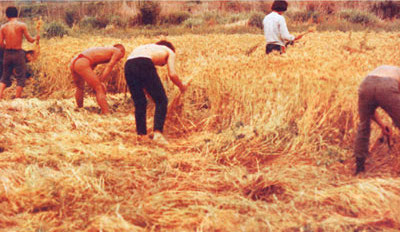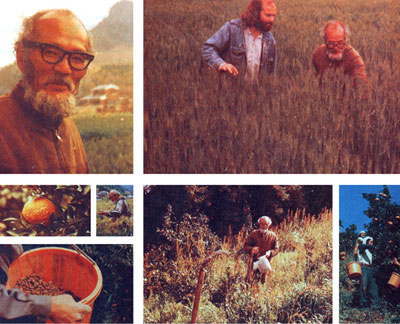
Fukuoka's natural farming
 So
what did Masanobu Fukuoka's natural farming technique look like?
In the fall, he seeded white clover, a winter grain (rye or barley),
and rice all at once into a field. The seeds were rolled in balls
of clay so that they could simply be dropped onto un-tilled soil rather
than being pushed beneath the surface.
So
what did Masanobu Fukuoka's natural farming technique look like?
In the fall, he seeded white clover, a winter grain (rye or barley),
and rice all at once into a field. The seeds were rolled in balls
of clay so that they could simply be dropped onto un-tilled soil rather
than being pushed beneath the surface.
That autumn, the clovers and
winter grains sprouted and grew while the
rice seeds waited. The clover formed a groundcover beneath the
rye or barley, crowding out weeds and fixing nitrogen to enrich the
soil. By spring, the winter grains were ready to be harvested ---
Fukuoka threshed
the grains
and tossed all of the straw back onto the fields, forming a thick
mulch. He added in a small amount of manure from his chickens,
but no other compost or fertilizer.
 Meanwhile, the rice had
already sprouted and started to grow. The
young rice plants were trampled down when the winter grains were
harvested, but quickly sprang back to life, growing amid weeds and
clover.
Meanwhile, the rice had
already sprouted and started to grow. The
young rice plants were trampled down when the winter grains were
harvested, but quickly sprang back to life, growing amid weeds and
clover.
The traditional method
of growing rice in most of Japan and China
consisted of flooding the rice paddies for the entire growing season as
a method of weed control, but Fukuoka realized that rice is actually
healthier when growing in damp, but not sodden, soil. So he opted
to flood his fields for a mere week in the spring, long enough to drown
out most of the weeds and weaken the clover, giving the rice a head
start. Then he dried the fields back out and the rice grew
happily above its nitrogen-fixing groundcover. In the fall, he
harvested the rice and once again returned the straw to the field,
along with seeds for next year.
Fukuoka noted that after
20 years of using his natural farming method,
the soil on his farm was much richer than when he began. He
harvested just as much grain (or more) from his fields as the
commercial farmers using chemicals nearby. And the photos in his
book look remarkably weed-free --- I'm jealous.
| This post is part of our One-Straw Revolution lunchtime series.
Read all of the entries: |
Want more in-depth information? Browse through our books.
Or explore more posts by date or by subject.
About us: Anna Hess and Mark Hamilton spent over a decade living self-sufficiently in the mountains of Virginia before moving north to start over from scratch in the foothills of Ohio. They've experimented with permaculture, no-till gardening, trailersteading, home-based microbusinesses and much more, writing about their adventures in both blogs and books.
Want to be notified when new comments are posted on this page? Click on the RSS button after you add a comment to subscribe to the comment feed, or simply check the box beside "email replies to me" while writing your comment.
